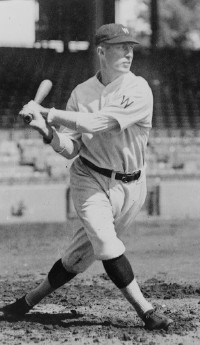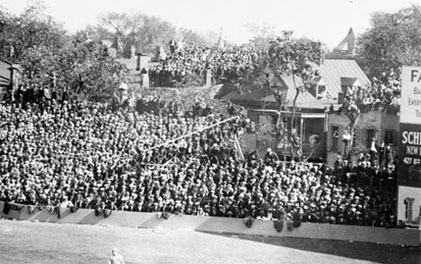|
Pivotal World Series Plays
Rice Makes Great Catch - Or Did He?
1925 World Series - Game 3 at Griffith Stadium, Washington DC; series tied one game each.
Top of the eighth: The Washington Senators lead the Pittsburgh Pirates 4-3. After the Senators went ahead with two runs in the bottom of the seventh, Player-Manager Bucky Harris removed slow-footed RF Joe "Moon" Harris for a defensive replacement in the top of the eighth. Harris moved CF Sam Rice to RF and put Earl McNeely in CF. The move paid off in spades right away. With relief specialist Firpo Marberry (one of the first closers, to use a modern term) on the mound, Pirate C Earl Smith strode to the plate with two out and nobody on base. Smith smashed a "mighty fly" to RCF. The ball seemed headed for the temporary bleachers that had been installed for the World Series. But Rice ran like a deer, "made a wild lunge," and caught the ball with his gloved left hand just in time to prevent a home run. His next step took him into the fence, and his momentum carried him over the fence and into the spectators. He immediately regained his footing and "whirled quickly and displayed it in his hand" (to quote an article the next day) to 2B umpire Charles Rigler, who had run out toward the fence to get a better view of the play. Rigler gave the out sign, retiring the side. That enraged the Pirates, who claimed Rice had dropped the ball when he went over the fence and then recovered it. The Pirates loaded the bases with one out in the top of the ninth, but Marberry got the next two batters on a popfly and a flyball to preserve the 4-3 victory and give the Senators a 2-1 lead in games.   L-R: Sam Rice, Temporary bleachers at Griffith Stadium for the 1925 World Series There were reports that some of the bleacherites swore an affidavit that Rice did not catch the ball. One reporter wrote, "From the stands (grandstand) it looked as if he did, because he whirled quickly and displayed it in his hand." That night, dozens of Pirates fans in Washington claimed they could produce affidavits from people who would swear that Rice never caught the ball. One fan even sent the commissioner a letter claiming that a "colored man" handed the ball to Rice.
Rice spent the rest of his life refusing to answer the question of whether he held onto the ball. All he would say was, "The umpire said I caught it." That was the same answer Sam gave the commissioner when Landis took him aside the day after the game and asked him if he caught the ball.Sam was inducted into the Hall of Fame in 1963. Every time he attended an event at Cooperstown, Lee Allen, the historian there, pestered Rice to write a letter that the Hall could keep when Sam passed away. By this time, McKechnie, a Hall of Famer himself, had changed his tune and thought that Rice had made the catch. (Winning the '25 series in seven games made McKechnie more magnanimous about the matter.) Rice told his wife and McKechnie that he planned to do what Allen asked of him. But when Rice passed away in 1974, no one could find any such letter at the Hall of Fame (despite his widow insisting he had written the letter). As it turned out, the letter was in the Manhattan office of Hall of Fame president Paul Kerr, who hadn't realized people were looking for it. Here's what the letter said. July 26, 1965
PostscriptIt was a cold and windy day; the right field bleachers were crowded with people in overcoats and wrapped in blankets, the ball was a line drive headed for the bleachers towards right center, I turned slightly to my right and had the ball in view all the way. Going at top speed and about 15 feet from [the] bleachers jumped as high as I could and back handed and the ball hit the center of pocket in glove (I had a death grip on it). I hit the ground above five feet from a barrier about four feet high in front of the bleachers with all my breaks on but couldn't stop so I tried to jump it to land in the crowd but my feet hit the barrier about a foot from top and I toppled over on my stomach into first row of bleachers, I hit my Adams apple on something which sort of knocked me out for a few seconds but [Earl] McNeely arrived about that time and grabbed me by the shirt and pulled me out. I remember trotting back toward the infield still carrying the ball for about halfway and then tossed it towards the pitcher’s mound. (How I have wished many times I had kept it). At no time did I lose possession of the ball. Sam Rice. Notice that Sam never said when or how he got possession of the ball. The third game of the 1925 World Series also included another odd play. A player batted out of turn in the bottom of the eighth and no one caught it except sportswriters keeping score in the press box. Here's what happened. In the bottom of the 7th, Nemo Leibold pinch hit for P Alex Ferguson and drew a walk. Looking ahead to the defensive change he would make in the top of the 8th, manager Bucky Harris had Earl McNeely run for Leibold. So when the inning ended and McNeely stayed in the game in CF, he occupied the ninth position in the batting order with Marberry, the new pitcher, taking RF Joe Harris's fifth spot. In the bottom of the 8th after Rice's sensational catch, the Senators' seventh-place hitter, SS Roger Peckinpaugh, grounded out. Then the eighth-place hitter, C Muddy Ruel, singled. That should have brought up McNeely. Instead, Marberry stepped to the plate and bunted Ruel to 2B. It would have been the responsibility of Pittsburgh manager McKechnie to protest after Marberry's at-bat. Marberry would have been out for batting out of turn but the runner on 2B would have been sent back to 1B. Fortunately to the Pirates, Rice, the leadoff hitter, grounded out to end the inning. McKechnie was considered one of the sharpest baseball minds of the time. So if he didn't protest, it must have been because he wasn't aware of the mistake. |